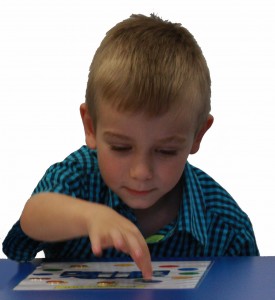
Developing Receptive Language before Expressive Language. This post was written by student speech pathologist, Kristen Brown as part of her placement at Talking Matters.
What is receptive and expressive language? Why is it important to develop receptive language before expressive? How can I target receptive language first?
Language is used as a means of communicating. Speech pathologists will often classify language into receptive language and expressive language. This is because communication is a two way process.
It involves an ability to understand a message (receptive) and to send a message to another person (expressive).
What is receptive language? Receptive language refers to the ability to understand spoken language. Children will understand many more words than they will be able to use and this is often referred to a receptive vocabulary. Help build your child’s receptive vocabulary by exposing them to lots of new words.
What is expressive language? Expressive language refers to the ability to verbally express words to convey a message. Children’s expressive vocabulary will continue to grow as they learn how to use new words. Support your child’s attempts to try to use new words as this will build their confidence.
Receptive language develops before expressive language. For a child to be able to communicate and learn, they need to be able to understand spoken language. A child will have difficulty talking or responding to a question if they are unable to understand what has been said. For this reason, it is important that a child is given the opportunity to develop their receptive language skills before focusing on their expressive skills. Providing a child with a language rich environment is the best way to develop a child’s receptive language.
Just because a child cannot say a word yet, doesn’t mean that the word isn’t in their receptive vocabulary! Every time a child hears a word they become more familiar with what it means and this will eventually result in the use of the word expressively. Developing the skills to understand language takes time, but this is an important skill for a child to learn in becoming a competent communicator.
How to make a task receptive, rather than expressive:
Reading a book to your child
- Encourage them to open the book and turn the pages – “Time to turn the page!”
- Ask them to find objects from the book around the house – “There is a television in this book! Can you find our television?”
- Use flap books and encourage them to look under certain flaps – “Can you find the pig? Look behind the door, he is hiding!”
- Photocopy pictures from the book and get them to blue tak them into the book as you read it – “we need to find a cow!”
Ask your child to point to or pick up an object rather than naming it:
- Put an array of toys or objects on a tray and ask them to find one
- Place objects in a bag and ask them to pull out a toy as you name it for them
- Ask them to point to all the blue puzzle pieces or point to all the dogs in the book
Play a game giving them instructions to follow:
- Have an array of toys or pictures and ask them to pick up a particular one and put it on a picture or in a toy house or on a car mat – “Put the car on the bridge!”
- Increase the complexity of instructions for them to follow i.e. “Put the dinosaur on the tree!” “Put the red dinosaur on the tree” “Put the red and green dinosaur on the tree”
- Use barrier games for older children to develop listening and comprehension
- Use lotto boards to target different vocabulary for younger children "find a ..."
- Play a game with instructions for them to follow such as "Simon says"
- Use toys such as Mr Potato-heads to follow instructions "put on the yellow hat"
Talk to your child when you are playing with toys together:
- Talk to them about what they are doing i.e. “You are feeding teddy! Teddy is hungry. Yum-yum, Teddy is eating the apple.”
- Avoid asking lots of questions, rather comment on what you or your child is doing.
Play children’s music and sing nursery rhymes:
- Having children’s songs on in the background will expose them to new language.
- Sing along and dance and make it fun!
- Put actions to the words in songs, rhymes and poems i.e. I’m a little tea pot
Find a list of songs and lyrics at:
http://www.kidspot.com.au/kids-activities-and-games/nursery-rhymes+15.htm
http://www.songsforteaching.com/nurseryrhymes.htm
Find more great ideas and activities on Talking Matters pintrest page.
If you are concerned about your child's receptive language or communication skills browse our website to find out how speech pathology can help.
Related Blog Posts
If you liked this post you may also like:
3 1/2 year olds
Verbs and conjunctions
Book Week, All About Stories!
Using barrier games



